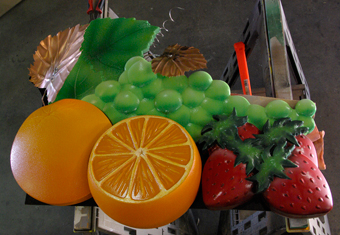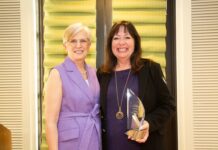The Fresno Chaffee Zoo is located in Fresno, California and plays host to a wide range of wildlife, environments, and agriculture. It’s also home to plenty of colorful, attention-grabbing identity, exhibit, and wayfinding signage.
The company exclusively doing all this sign work for them the past two-and-a-half years is Diverse Signs, also of Fresno, California.
“We’ve built and installed all their ‘coming events’ signage as well,” says Co-Owner Lonnie English.
Diverse Signs has been in business for fifteen years now and offers a variety of signage solutions, including: exterior and interior signage; vehicle, aircraft, and boat graphics; banners; cut letters and sign blanks; and decorative concrete stencils and forms.
And this business remains solely all in the family: Lonnie handles fabrications, while his wife Heidi works on the computer and their son Kyle provides graphic designs and helps out with installations. They’ve also proven successful at using their design and CNC routing skills to really grow their signage success.
Speaking of “growing,” officials from Fresno Chaffee Zoo recently approached Diverse Signs requesting the creation of a dimensional identity sign for a redesigned section of their property, Valley Farm, which is where kids and visitors can pet farm animals and see how fruits, vegetables, and trees are planted.
One hundred percent of the sign design was provided to Diverse Signs by Heather Davis, who works in the zoo’s marketing/graphics department. It features the fruits that are grown in the Central Valley of California (tomatoes, oranges, grapes, strawberries, etc.), as well as area flowers, a barn (representing the farmyard animals), and a rising sun in the background. It was up to the shop to figure out how to make this design a dimensional sign reality.
Lonnie and his family looked at the provided design sketch and started brainstorming the different elements and levels that could be created dimensionally, to make things “pop” off the sign.

Once they figured out these soon-to-be-3D elements, Heidi scanned the original design artwork into the shop’s computer and then exported it into ArtCAM software. There she developed the cross-sections that are often needed in 3-D signs.
Next she generated a toolpath and G-code so that the components of the sign could be produced on their MultiCam 3000 CNC router.
The individual pieces, panels, and letters on the sign were made out of fifteen-pound Precision Board HDU and cut to various-sized shapes. (Note: Other materials Diverse Signs uses—and recommends—for its dimensional sign work include Extira® treated exterior panels, Alupanel® aluminum composite sheet, and Nudo sign panel products.)
In addition to the fruits and vegetables, another portion of the sign design that the Englishes thought would make excellent dimensional pieces were the individual leaves that hang over certain elements of the sign. They made this foliage from copper and cut them separately from the other pieces. “We used copper for the leaves because of its formability,” says Lonnie, “and its outdoor life.”
However the shop had to find a way to mount the copper leaves from the backside of the sign, so that they would be able to come out in between the different layers of material.
And since the Englishes strive for realism, this created additional challenges. “We had to make sure that we laid them out so that one leaf didn’t get in the way of the other,” says Lonnie.
Diverse Signs took a piece of UHMW plastic and cut the shape of the leaf with it. This also used it to give the leaves veins so they would look a little more realistic.
“We then cutting the leaf out on the CNC router to give it its finished shape,” explains Lonnie, “and then we laid it on top of the buck and pounded it with a soft-head hammer. That creates the impression of the veins inside the leaves.”
After the painting was done, stems were added to the leaves via soldering.
All painting was accomplished using urethane base/clear coat automotive finish. “Automotive paint has the best durability. It’s made to go on cars, so naturally, it’s going to last outdoors almost as well as anything else you can put on it” says Lonnie, noting that they also applied airbrushing to touch up some of the pieces.
(Note: Diverse Signs primed the HDU pieces with FSC 88 and PCL Polyester Primers and used 3M™ Rocker Panel Spray on the oranges, in order to get the texture they needed.)
The finished sign measures 65-by-132 inches and is mounted to a wooden gateway structure that the zoo had agreed to build and install shortly before the sign arrived.

“The zoo officials gave us the drawings and measurements on what they were going to put up, so that we knew how big the identity sign could be built,” details Lonnie.
For installation purposes, all the HDU panels were stud-mounted to aluminum backers using West System Epoxy.
“We ended up cutting the HDU separately,” explains Lonnie, “and then we cut the aluminum afterwards to fit them. So when we were scheduled to go out to the site for installation and glue everything together out there, we wanted the mounting to already be on it.”
The support part of the sign frame was built using one-inch square tubing and powder-coated, which kept everything light for the ladder-based installation.
“Then we were able to bring the pieces of the sign back up and put those on one piece at a time,” says Lonnie.
The sign was built in five separate pieces, and because the Englishes had already attached the mounting-related pieces to the back of them, installation proved a breeze.
“We just put each section up, ran it through the bolts, and then put nuts on the backside of it,” says Lonnie. “And if we ever need to make a repair to the sign down the road, we can go back up and take that one section off, fix it, and then put it back up.”
In total, it took Diverse Signs about four weeks to complete the sign.
“This was a fun sign to create,” says Lonnie. “We love seeing the creative designs that the zoo provides us with, and we love being able to make these signs a reality for them.”











